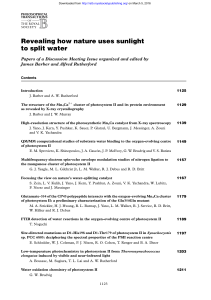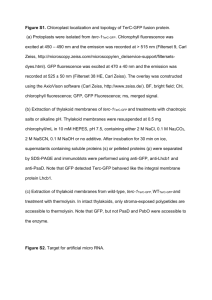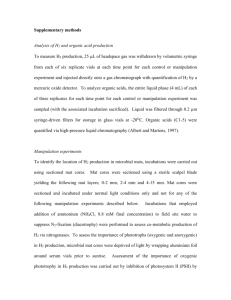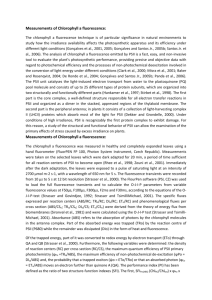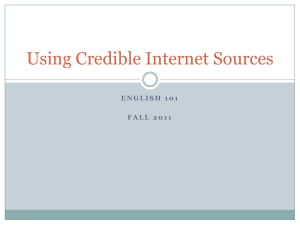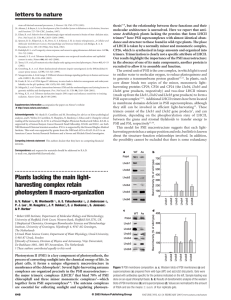Tougher Plants Power Point
advertisement
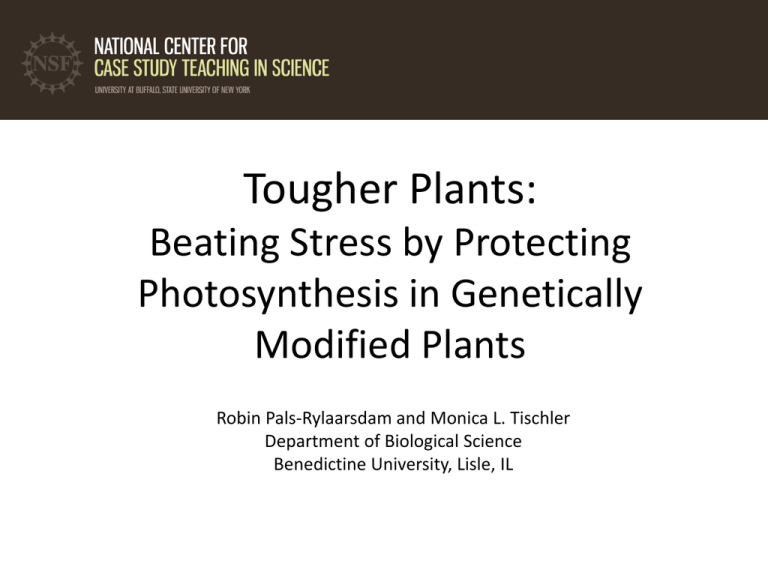
Tougher Plants: Beating Stress by Protecting Photosynthesis in Genetically Modified Plants Robin Pals-Rylaarsdam and Monica L. Tischler Department of Biological Science Benedictine University, Lisle, IL Plants are subject to many stresses • The main stressors are: Cold Heat Salt Frost damage Heat damage Road runoff Irrigation evaporation or drought Glycine betaine is a molecule that moderates stresses in plants Plants are subject to many stresses • The main stressors are: Cold Heat Salt Frost damage Heat damage Road runoff Irrigation evaporation or drought Plants were exposed to 3C for 7 days, then transferred to the warm greenhouse. Wild type Transgenic What does wild type mean? What does glycine betaine do for the leaves, flowers and fruits in cold-exposed plants? NB: This figure is a simulation of a figure in the original article. What does glycine betaine do? Figure 3. Effects of chilling on various growth parameters. Five-week-old greenhousegrown wild type and independent homozygous transgenic lines (L1, L5) were chilled (3°C) for 5 days, then returned to greenhouse. What is the X-axis measuring? What is the Y-axis measuring? What does “WT” mean? What are L1-L9? Which process of photosynthesis is most affected by ion leakage? a. b. c. d. Whether the cells can capture light Whether the Calvin Cycle will function Whether ATP synthase will function Whether electrons will transfer from PS II What trends can you observe? (write down 2, share with your neighbor) Figure 3. Effects of chilling on various growth paramaters. Five-week-old greenhousegrown wild type and independent homozygous transgenic lines (L1, L5) were chilled (3°C) for 5 days, then returned to greenhouse. Plants are subject to many stresses • The main stressors are: Cold Heat Salt Frost damage Heat damage Road runoff Irrigation evaporation or drought Figure 4. Changes in the oxygen-producing activity of PSII determined with thylakoid membranes isolated from leaves after exposed to different temperatures 25, 30, 35, 40, 45, or 50°C in the chambers for 4 h, in wild type and transgenic plants. The values are mean + SE of three independent experiments. Oxygen-evolving activity of PSII (mmol O2 mg-1 Chl h-1) 400 300 200 WT 100 Genetically modified 0 20 25 30 35 40 45 Temperature of treatment 50 (oC) 55 What is the X-axis measuring? What is the Y-axis measuring? What are the two types of plants in this experiment? Which process in photosynthesis produces O2? Oxygen-evolving activity of PSII (mmol O2 mg-1 Chl h-1) 400 300 200 WT 100 Genetically modified 0 20 25 30 35 40 45 Temperature of treatment 50 (oC) 55 a. b. c. d. PS I PS II ATP synthase light capture Make two observations from the data: Write them down, then share them with your neighbor. Oxygen-evolving activity of PSII (mmol O2 mg-1 Chl h-1) 400 300 200 WT 100 Genetically modified 0 20 25 30 35 40 45 Temperature of treatment 50 (oC) 55 Figure 4. Changes in the oxygenproducing activity of PSII determined with thylakoid membranes isolated from leaves after exposed to different temperatures 25, 30, 35, 40, 45, or 50°C in the chambers for 4 h, in wild type and transgenic plants. The values are mean + SE of three independent experiments. Photosystem II Structure of Photosystem II, PDB 2AXT http://en.wikipedia.org/wiki/File:PhotosystemII.PNG Which part of the molecule goes through the membrane? a. Blue box b. Red oval c. Trick question, this a big mess of squiggles! Structure of Photosystem II, PDB 2AXT http://en.wikipedia.org/wiki/File:PhotosystemII.PNG So, the blue box is trans-membrane. The part below the blue box is associated with the membrane. Structure of Photosystem II, PDB 2AXT http://en.wikipedia.org/wiki/File:PhotosystemII.PNG Which of the following could explain why increased temperatures decrease PSII activity? a. Thylakoid membranes become more permeable to ions b. The chlorophyll breaks down c. The peripheral proteins lose their ability to bind to the transmembrane proteins d. Water cannot bind to PSII to form oxygen. Structure of Photosystem II, PDB 2AXT http://en.wikipedia.org/wiki/File:PhotosystemII.PNG Plants are subject to many stresses • The main stressors are: Cold Heat Salt Frost damage Heat damage Road runoff Irrigation evaporation or drought What is the X-axis measuring? What is the Y-axis measuring? What do lines a, b, and c refer to? Make two observations, write them down, and share them with your neighbor. Which subunit is most stable and likely to be in the membrane? A B C Which subunit is least stable and likely to be a peripheral subunit? A B C What does glycine betaine do to protect PSII activity? All the parts need to be together for photosynthesis! PS II needs to work Membrane can’t leak so ATP synthase works Credits Slide 5 Description: Susceptibility to cold stress at different plant stages. Source: Photos by Robin Pals-Rylaarsdam. This figure is intended to simulate Figure 6 in Park, E.-J., Jeknić, Z., Sakamoto, A., DeNoma, J., Yuwansiri, R., Murata, N. and Chen, T. H. H. (2004), Genetic engineering of glycinebetaine synthesis in tomato protects seeds, plants, and flowers from chilling damage. The Plant Journal, 40: 474–487. Slides 6 & 8 Description: Effects of chilling on various growth parameters. Source: Redrawn and adapted from Figure 5(g) in Park, E.-J., Jeknić, Z., Sakamoto, A., DeNoma, J., Yuwansiri, R., Murata, N. and Chen, T. H. H. (2004), Genetic engineering of glycinebetaine synthesis in tomato protects seeds, plants, and flowers from chilling damage. The Plant Journal, 40: 474–487. Slides 10, 11, & 12 Description: Changes in the oxygen-producing activity of PSII. Source: Redrawn and adapted from Xinghong Yang, Xiaogang Wen, Hongmei Gong, Qingtao Lu and Zhipan Yang, et al. (2007), Genetic engineering of the biosynthesis of glycinebetaine enhances thermotolerance of photosystem II in tobacco plants, Planta, Volume 225, Number 3 (2007), 719–733. Slides 13 – 16 Descriptionv: Photosystem II. Source: Modifi ed from image by Curtis Neveus, used in accordance with the Creative Commons Attribution-Share Alike 3.0 License, from Wikipedia at http://en.wikipedia.org/wiki/File:PhotosystemII.PNG. Slides 18 – 22 Description: Effects of betaine. Source: FEBS Letters, 296(2), N. Murata, P.S. Mohanty, H. Hayashi, G.C. Papageorgiou, Glycinebetaine stabilizes the association of extrinsic proteins with the photosynthetic oxygen-evolving complex, 187–9. Copyright (1992), with permission from Elsevier. http://www.febsletters.org/. Slide 23 Description: Photosynthesis Source: Modified from a work released into the public domain by its author, Tameeria at the wikipedia project, http://commons.wikimedia.org/wiki/File:Thylakoid_membrane_2.svg.

